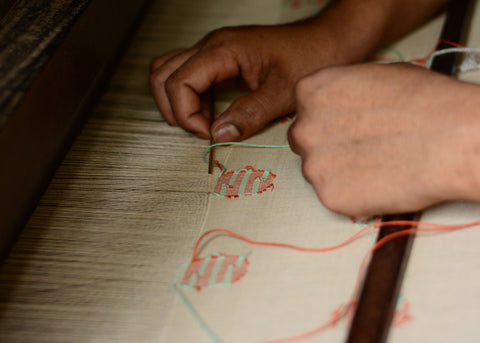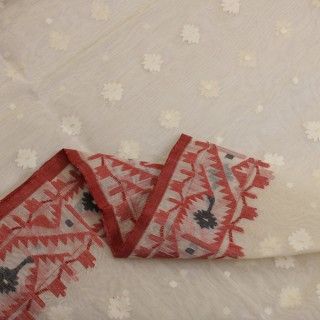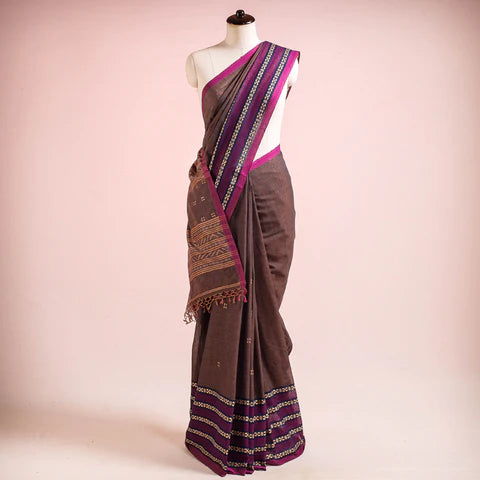Jamdani is a handloom craft that finds its origins in Bengal, India. The Jamdani weaving technique focuses on creating intricate patterns/motifs on fine cotton or silk fabric. The process is time-taking and involves hand-tying individual threads to initiate the weaving work on a manual loom. The resultant Jamdani fabric is airy, lightweight, and highly detailed.
Being a handloom art of the Bengal region for years, Jamdani weaving is popular for its traditional value and elegant charm. In an attempt to recognise and appreciate the cultural and historical significance of Jamdani, it was declared a UNESCO intangible cultural heritage of humanity in the year 2013. This UNESCO designation has helped highlight handloom art and bring it attention and fame on a global level.

What is Jamdani?
Jamdani is a type of handloom weaving method. Jamdani related to the skilled craftsmanship of weavers to create intricate and beautiful designs/ motifs on muslin cloth. The process entailed using the fine muslin fabric to ensure that the resultant product is fine and breathable. With time cotton and silk fabric replaced the original muslin base fabric used to create jamdani work.
If you’re still wondering “what is jamdani”? Jamdani weaving is particularly famous in the Bengal region of India. Owing to its widespread use and production for ages, the cultural significance of Jamdani is irrefutable. The fabric type with its flawless and typical making is often associated with traditional clothing, such as sarees, handloom shawls and dhotis.
What Is A Jamdani Saree? History And Origin
Jamdani sarees have a rich history that dates back to the Mughal era in India. The art of Jamdani weaving has its origins in the Indian state of Bengal. Though the major part of Jamdani weaving took place, particularly in Dhaka (in undivided India), and was patronised by the Mughal emperors. The beautifully adorned, and skillfully crafted muslin fabric loom was spun majorly in the Narayanganj district of then Bengal, which is now part of Bangladesh.
The craft took shape in the Narayanganj district along the river banks of Shitalakhwa River. The close proximity to such water bodies, like a river, provided ample water supply necessary for the process of softening, spinning, finishing etc. Jamdani weaving also made use of such techniques to consequently give form to the brilliant jamdani fabric.
Initially, the jamdani weaving resulted in looms of only white and grey colours. The sarees, dhotis and other everyday clothing were worn for the comfort that the fine cotton fabric afforded. Intricate designs and elegant drapes of the jamdani weave added to its prestige and became essential to the cultural attire, especially in Bengal. Till date, Jamdani sarees remain an important part of traditional Indian clothing, particularly in the Bengal region for significant events like weddings, festivities and religious ceremonies.

How Does Jamdani Weaving Take Place?
The steps involved in the creation of Jamdani loom like any other, are designing, working on the loom and finishing. For effective Jamdani weaving warp preparation, weft preparation, setting up the loom, weaving, beating, and finishing are essential steps. Though the process and steps may differ a little depending on the desired outcome and individual techniques. Typically these steps are widely accepted and followed.
The special method of Jamdani weaving is that the designs are created by hands on the loom while using individual threads, at a time. Unlike other weaving methods Jamdani weave requires precision, an eye for details and dedicated artisans. No use of pre-dyed or printed fabric is opted.
The entire process of Jamdani weaving requires the weaver to have a sharp memory, dexterity and focus. Skillfully made Jamdani weave is like no other. Jamdani is a delicate and beautiful handloom product that has a peculiar sheen, and drapes perfectly in saree or dhoti form. The singular threads used in creating jamdani weave can’t be differentiated in the final loom through our naked eyes.
The final Jamdani weaving product is highly valued for both its exceptional skills and traditional importance.
 (image credit:- Anuprerna)
(image credit:- Anuprerna)
Motifs And Techniques Involved In Jamdani Weaving
Most handloom products in India come with a variety of designs and patterns, either embroidered or printed on them. Jamdani weaves are no different in this regard, except that the motifs made on them look prettier owing to the beautiful weave of the fabric. Some of the common motifs and techniques used in Jamdani weaving:
Jamdani Weaving Motifs:
 (image credit:- Pinterest)
(image credit:- Pinterest)
- Floral designs can commonly be seen such as lotus, rose, and jasmine, which add an extra element to the beauty of the saree
- Another design, a little uncommon yet gorgeous when done right, are geometric shapes. Diamonds, squares, checks etc. make for a mesmerising pattern on this type of weave
- Sometimes the sarees in the jamdani weave type comprise designs like that of animals and birds. Such motifs like the peacocks, parrots, or elephants are time-taking to execute but the designs are a sight to behold once done
-
Jamdani weaving in sarees and other garments sometimes consists of mythological motifs as adornments. As deities are held in high esteem in the Bengali culture like the rest of India, you can easily find a representation of gods and goddesses on traditional garments as beautiful, and intricate designs
Jamdani Weaving Techniques:
Few commonly used techniques in Jamdani weaving have been touched upon briefly. Read on to learn about them:
- Double cloth weaving: This particular technique entails weaving two layers of fabric together, with the main intention of having the design appear on both sides in the final product.
- Butidar weaving: As the name suggests this method involves weaving various buti motifs into the fabric. Such a technique adds texture to the weave style and the intricate pattern makes the saree stand out.
- Dhakai weaving: Dhakai style of Jamdani weaving basically relates to weaving complex designs on finer cotton fabrics. These often come with either a white or off-white background.
- Jala weaving: An interesting take on the art of weaving, this method involves the creation of small holes in the fabric by weavers. Such an intricate method of removing warp threads slowly ends up giving a lace-like effect to the final loom.
-
Tant weaving: In this method, weaving is done with fine cotton threads.Such a weave results in a lightweight and airy fabric. Tant weave is famous as the light cotton fabric is extremely breathable and comfortable.
Jamdani Sarees Ideas: Style The Different Types Of Jamdani Weaves In Many Ways
Though you may be aware that there are several types of Jamdani made in India. For your reference, we’ll mention them briefly. A few of the most popular and widely purchased types of Jamdani comprise the following:
- Dhakai Jamdani:
The Dhakai type of Jamdani weave which originated in Dhaka, Bangladesh is one of the most popular types of Jamdani. Jamdani saree features complicated floral or geometric designs made on fine cotton or silk fabric.
-
Tangail Jamdani:
Originating in the Tangail district of Bangladesh this type of Jamdani weaving is famous for its use of bright and bold colours. The vibrant colours used alongside the beautiful large designs make this Jamdani looms, pretty and easily distinguishable.
-
Shantipur Jamdani:
This particular type of Jamdani weaving is known to have begun in the town of Shantipur in West Bengal, India. It is known for its intricate designs that are work of sheer dedication and great skill. The use of pastel colours is unique to these sarees that imparts an ethereal and sophisticated charm.
-
Dhanaikhali Jamdani:
The Dhaniakhali type of Jamdani weave comes from the Dhanaikhali district of West Bengal. This weave is famous for the use of thick cotton threads to make the loom. The usage of thicker cotton threads instead of regular thin ones gives the final products some texture that feels rich and comfortable at the same time.
-
Begumpuri Jamdani:
As obvious from its name this type of Jamdani weave has come down to us from the town of Begumpur in West Bengal. Begumpuri type of loom often features geometric designs on fabrics dyed in earthy tones. In totality, this type of Jamdani weave provides a bold but rustic feel. 
Though we’ve referred to some types of Jamdani, based on origin, different Jamdani weaves exist on the basis of the fabric, techniques etc. We’ve touched upon various types of Jamdani weaving. Researching further, you may end up finding more techniques, motifs and weaving styles. However, it is fair to say each has its own unique style and history.
Present-Day State Of Jamdani Weaving And Artisans
In contemporary India, Jamdani weaving continues to be a popular choice of cloth for traditional clothing. The craft is practised by skilled artisans in the state of Bengal, India. Other producers include the western region of Bangladesh.
Though the jamdani handloom production faced several challenges in recent years, it has maintained its customer base by being consistent in providing the best quality loom. The hurdles of competition from cheaper, machine-made fabrics remain, but power loom can neither compete with the attributes of handloom nor its attributes. Jamdani weaving still has sufficient demand in the market because of its high quality and the cultural significance attached to it.
As touched upon in the article earlier, efforts are being made to ensure that the handloom business stays afloat and thriving. The recognition of types of Jamdani weaving by UNESCO and a continuous revival of handicrafts lately, including handloom, have helped skilled artisans and business owners keep working to preserve this craftsmanship and run their households. The livelihoods of the weavers remain unharmed and this traditional technique shall continue to be passed down to future generations.

Conclusion
It is obvious without a shadow of a doubt that Jamdani weaving is part of the great traditional and cultural heritage of India. This handloom art was famous for its brilliance centuries ago, and continues to enjoy a place of eminence even today.
The recognition endowed on Jamdani weaving by UNESCO has definitely promoted the art form. Such recognition has made the handloom craft known not just in India but worldwide, making sure that the craft is preserved and supported in modern times. Subsequently, the demand for Jamdani looms has witnessed a rise in the past century.
Thus, we’d suggest that if you’ve not experienced the charm of this lightweight, almost sheer, soft and beautiful weave, place your order soon. And if you know the pleasure of donning the remarkable jamdani weave, we’re sure you’ll keep coming back for more.
Frequently Asked Questions
-
Is Jamdani a weave?
Another special aspect of Jamdani weaving is the use of fine and lightweight cotton or silk threads, which result in a delicate and airy fabric that drapes beautifully. The threads used in Jamdani weaving are often so fine that they can be difficult to see with the naked eye, making the weaving process even more challenging and requiring a high level of attention to detail.
-
Jamdani weaving belongs to which state in India?
Jamdani weaving belongs to the Indian state of West Bengal. With its recognition as part of the great culture of India and world heritage, it has become popular worldwide. Recent awareness campaigns regarding Jamdani weaving and its importance as an art form, have shown growth in the industry and product sales.
-
What is the Jamdani style of weaving?
Jamdani style of weaving utilises fine threads to work on the loom. The weft technique used is special as each thread is individually added to weave the final product. An important aspect of Jamdani weaving style is the use of heavier threads for embroidery and finer threads to make the airy base fabric.
-
When and where did Jamdani weaving originate?
Jamdani weaving has its origins in the Indian subcontinent. The weaving style began in the state of West Bengal, India. Other places like Bangladesh also produce Jamdani handloom. As per historical and cultural accounts, Jamdani was popularised and saw its prime during the later Mughal period in pre-partition India.
 Verified Purchase
Verified Purchase
























































Leave a comment (all fields required)